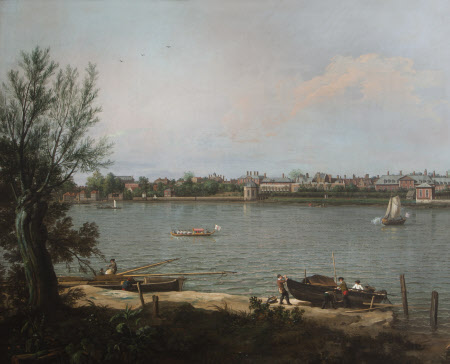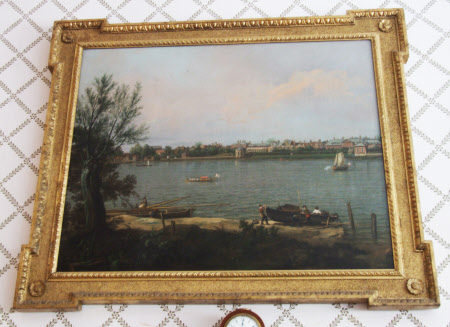Chelsea from the Thames at Battersea Reach
Antonio Canaletto (Venice 1697 - Venice 1768)
Category
Art / Oil paintings
Date
1751
Materials
Oil on canvas
Measurements
1095 x 1295 x 60 mm
Place of origin
London
Order this imageCollection
Blickling Hall, Norfolk
NT 355474
Caption
This picture is the left half of what was formerly an extensive view, ranging from the greenhouse of the Physic Garden to Ranelagh Gardens. This picture shows from left to right: the greenhouse of the Physic Garden, part of Paradise Row; Turret House (with cupola); Gough House; Sir Robert Walpole's greenhouse, art gallery and casino; and one end of Chelsea Hospital. The picture was cut in two sometime before 1802, the other half now in the National Museum, Havana, Cuba. This was perhaps one of his “8-footers”, originally commissioned by a client with a special interest in the site shown, which was then left on his hands for some reason or other. The artist himself may then have cut it in two to make it more saleable.
Summary
Oil painting on canvas, Chelsea from Battersea Reach by Canaletto (Venice 1697 – Venice 1768), 1751. River across centre, buildings on far shore, tree at left, shore in foreground, boats and figures. It shows from left to right, the greenhouse of the Physick Garden, part of Paradise Row; Turret House (with cupola); Gough House; Sir Robert Walpole's greenhouse, art gallery and casino; and one end of Chelsea Hospital. The original painting was cut in two, before 1802, with the right half, with the rest of the Hospital and Ranelagh Gardens, now in the National Museum, Havana, Cuba.
Full description
This picture was once part a larger picture that was cut in two at an unspecified date before 1802. This painting forms the left side, while his painting forms the left side, while The Thames with Chelsea College, Rotunda and Ranelagh House at the Museo Nacional de Bellas Artes in Havana, is the right side. Together, they embrace a wide view of Chelsea with its houses and gardens stretching out along the Thames, shown from the opposite bank of the river on Battersea Reach. Canaletto painted this work immediately after returning to London from his eight-month journey to Venice, and announced its presence in the second advertisement published in the Daily Advertiser on 20 July 1751, almost two years after the first, dated 25 July 1749: ‘Signior Canaletto / Gives notice that he has painted the Representation of Chelsea College, Ranelagh House, and the River Thames, which any Gentleman and others are pleas’d to favour him with seeing the same, he will attend at his Lodgings, at Mr Viggan’s, in Silver Street, Golden Square, for fifteen Days from this Day, the 31st of July, from Eight o’Clock in the Morning to One in the Afternoon, and from Three in the Afternoon to Six at Night, each Day’. The event was promptly mentioned by George Vertue (1934, III, p. 158) in August or September of the same year: ‘Lately …. Canaletti. Painter has painting [sic] a large picture a View on the River Thames. Of Chelsea College. Ranelagh gardens & c.an [d] parts adjacent. With barges & boats figures – this he exposed to public View at his Lodgings – being a work lately done to shew his skill – this valud at 60. Or 70 pounds. […] this View is not so well as some works of Canaletti formerly brought into England. nor does it appear to be better than some painters in England can do’. It is now known to what extent the unjustified severity of this opinion influences the history of the picture but its cutting into two may have been caused by a difficulty in selling it, either by the painter himself or by an eighteenth-century owner. The right side of the painting reappeared in a Christie’s auction on 24 April 1802 (lot 30) with the correct attribution while this one, assigned with a nineteenth-century text on the stretcher to Samuel Scott (1702-1772), and registered with this name for the first time in 1931 at Outer Hall of Newbattle Abbey, residence of the Kerr family (as confirmed by Robert Wenley, quoted by C. Beddington), was recognised as being by Canaletto only in 1955, during the revision of the insurance premium. It was linked to its other half by Francis Watson. In the picture at Blickling Hall, from left to right, are depicted the Greenhouse of the Chelsea Physic Garden in the southern part of Paradise Row, famous for its medicinal plants, which had been transferred to Chelsea from Westminster in 1676 where the garden had been founded three years earlier by the Society of Pharmacists. The building with a dome is Turret House, while further to the right there are Gough House and the greenhouses, the art gallery and the octagonal pavilion of Walpole House, residence of Sir Robert Walpole House, residence of Sir Robert Walpole; on the right side, there is a wing of Chelsea College, now Chelsea Hospital, designed by Sir Christopher Wren in 1682. The houses of Chelsea, surrounded by greenery, are flooded in a delicate and clear light. The canvas is lower than the other by about 9 centimetres, which was cut at the bottom and top, as well as at the left margin, where a part of the tree has been lost, but it has probably remained intact along the joint itself, as Chelsea College continues in the Havana Museum painting. It was noted that originally the painting was among the five of the largest to be produced in England; the other four are the two views of the Thames in the Lobkowitz collection, Whitehall belonging to the Duke of Buccleuch and Old Horse Guards from St James’s Park belonging to the Andrew Lloyd Weber Foundation, which was the subject of the first announcement in the Daily Advertiser. The unusual predominance of the river that occupies half of the canvas suggests that both parts had the sky cut down, which originally, probably, was of the same height of the other four; approximately 122 CM. This seems confirmed by a photograph of a copy of the entire painting in the Lancaster Collection at Grimsthorpe Castle, preserved in the Courtauld Photographic Survey and mentioned for the first time by C. Beddington. The naturalistic rendering of the willow that frames the view, wholly new and never repeated, plus the plants in the foreground, which have also been painted from life and characterised by differentiated and recognisable leaves, express Canaletto’s desire to show knowledge of the latest trends in English painting, inspired by the 17th-century Dutch school. A few years later, in 1753-1755, his nephew Bellotto in the Saxon town of Pirna revealed similar interests. Text by Bozena Anna Kowalczyk adapted from Kowalczyk, Canaletto: 1697-1768 (exh. cat.), Rome: Silvana Editoriale, 2018, p. 168.
Provenance
Philip Kerr, 11th Marquess of Lothian (1882-1940), 1921; by whom bequeathed to the National Trust
Credit line
Blickling Hall, The Lothian Collection (National Trust)
Makers and roles
Antonio Canaletto (Venice 1697 - Venice 1768) , artist previously catalogued as attributed to Samuel Scott (London 1703 – Bath 1772), artist
Exhibition history
Canaletto 1697-1768, Museo di Roma, Palazzo Braschi, Rome, Italy, 2018
References
Kowalczyk 2018: Bozena Anna Kowalczyk, Canaletto: 1697-1768 (exh. cat.), Rome: Silvana Editoriale, 2018., cat. 47, pp. 168-9.

